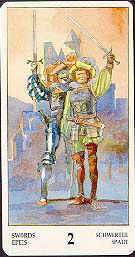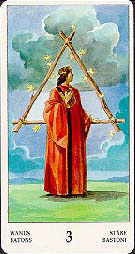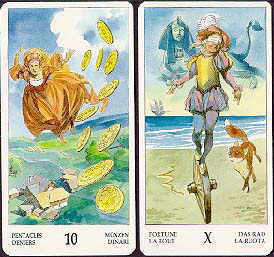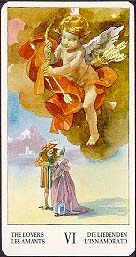Tarots of the Renaissance Deck Review
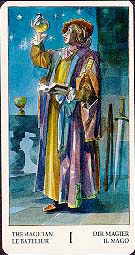
The Tarots of the Renaissance cards are in an Italian Renaissance style, and was painted in what looks like watercolours. This Tarot deck is an interesting visual interpretation of a previous era.
Deck Type: Tarot Deck Cards: 78
Creators: Giorgio Trevisan
Publisher: Lo Scarabeo
Retailers
See Price at Amazon.com (Mini)See Price at Amazon.co.uk
See Price at Amazon.ca
Tarots of the Renaissance Review by Cerulean
I just heard that in 2006 there will be a new miniature version of a personal favorite of mine. The artwork is Giorgio Trevisan's "Tarots of the Renaissance." A more apt name might be "Tarots of A Renaissance Faire" for its quaint charm. I see costumes of swirling cloaks, long robes, aprons and sashes. The people are swashbucklers, maids, ladies, artisans, knights, jugglers, and merchants. I enjoy the feeling of enchanted castles, farms, villages and seashores. The people depicted are all ages, shapes and sizes.
This deck reminds me of Western European historical fantasy and children's tales. I found an Italian children's book illustrated by Trevisan with beautiful costumes and classic portraits. I found it charming to see that the Trevisan paintings seemed familiar. The Renaissance deck that reminded me of calendars of "Tuscan" villas and Italian art studies. Trevisan was born in the 1930's and has worked as an illustrator for several decades. A nostalgic look and feel to this tarot seems to be charming and natural to me.
I first found the 78 card version in 1998 after I read Mark Filipas' review of the 1995-1998 Lo Scarabeo Tarocchi D'Arte edition of the deck. I also have a majors-only 'postcard' size version with the same pictures.
The 1995-98 Lo Scarabeo Art edition was packaged as I Tarocchi del Rinascimento or Tarots of the Renaissance. These 78 cards were the size of regular playing cards (2 3/8 inches by 4.5 inches). These editions included nine cards with traditional keyword meanings. Mark Filipas in his review suggested the scenes show alternative meanings from the circa 1910 (Pictorial) Key to the Tarot or the 1979 Tavaglione's Stairs of Gold. I thought Giorgio Trevisan's designs would be interesting to explore. I've been enjoying my return to some of my personal favorite reading decks.
I bought the large-format Renaissance Tarot in 2000 for the bigger cards and new instructions. It turns out my older and smaller size worked better. I ended up cutting down the instructions of the newer deck and laminating them. The reissued and larger-size Renaissance had lighter coloring and the instructions have a gentle interpretation of the 78 cards. I've heard some people feel the lighter coloring of the larger cards as 'insipid' or 'weak'. My earlier printed version of the cards seem to be darker and richer to me. I still find a delicacy of the colors and features of the people in the pen and ink illustrations and washes.
The editors from Lo Scarabeo did a nice summary of warm and kindly meanings for this deck. After some years of working with this deck, I've added my own thoughts as well. I'm enclosing a summary here of some notes that I'm developing of the majors. Someday I'll address the minors-which have their own charms and additional richness to me.
In my notes below, I found that on the whole Trevisan's illustrations seem to not only suggest Waite-style keywords, but also might remind me of Oswald Wirth and Milanese Tarocco designs. My notes place Justice as Eight, Strength as Eleven and the Fool as 0, but last in the sequence. The original design concepts for Tarots of the Renaissance are credited to the art direction and founder of Lo Scarabeo, Pietro Alligo.
+++++++++++++++++++++++++++
I. Magician. This alchemist in a purple coat seems to be on the roof of a castle or house. He has all the magical tools that he needs nearby. You might think he is missing his pentacle or denari (coin)element--except for his attention on his upraised flask. He seems to have arrived at his goal, from his smile at the flask of fluid in one hand and clasping his open book in his other hand. The fluid appears to be gold against a night sky. His inner robe and decorative trimming are also a warm amber color.
II. High Priestess or La Papessa. Just at the edge of daylight, she sits beneath a canopy, dressed in a dark and ceremonial robe. The closed book resting on her lap has a yin-yang symbol in a Tuscan red and white on yellow; the same shade of terra cotta red is on the canopy. Red and white in some Asian cultures-as the Japanese "Kohaku"-- is a sign of good luck and strong life. Her shadow indicates sunlight is at a bright angle; she is between red and blue pillars. Her feet rest on a warm sienna brown cushion and her high-backed chair is made of wood. She looks dreamily at the distant shade of the trees across a green field. Her veil is transparent and drawn back from her smiling face. All her mysteries seem gently hinted at in this daylight scene.
III. Empress. She holds a scepter with delicate filigree fingers at the end. A vase of three flowers that matches the soft color of her dress is just behind her. She is dressed in a floral or leafy pattern in gold and orange and white. Her white cuffs and ruffled collar are pristine. She slightly inclines her crowned head toward us. A griffin or royal figure on a shield is hanging from the near curtain to the viewer. The hangings are a sienna brown touched with a faded red, matching the tones in the Emperor's room.
IV. Emperor. The warrior king is suited for a parade or victory battle, his royal cloak and feathered cap quite grand. The eagle emblem on his shield hangs on the wall. His sword is sheathed in a hilt. He holds a scepter similar to the one that Empress holds. His scepter is in his left hand, as if he just picked it up from the table. His chin is also lifted slightly and he stands very straight.Side by side to the Empress, you would hardly notice she is slightly taller. The hangings of the walls are tinted a faded red and match the Empress' surroundings; a small window and shadows in the room indicates daylight.
V. Pope. A young clerical figure stands in the full face of the sun. Shadowy terraced mountains and buildings show in the distance. The sun has a calm radiance. The gentleman points upward and holds a book to his chest. His violet robes have a yellow insignia that looks like a Papal scepter. His noble bearing and serene landscape and lake around him shows a country retreat, outside of the city. The blessing, in this scene of beauty, seems a natural benediction in harmony with land around him.
VI. Amor or Cupid is hiding behind a cloud with an orange-red cloth floating around him. This is part of his disguise in a cloud bank of a dusky hue. He is drawing his bow and peering at the hazy daylight scene of two people below him.
A noble addresses a capped lady, her hand in his. Is he asking her to choose or letting her know of news? The earnest pose suggests a path or choice that might become serious news to her. They whisper:
If we devote our hearts to this,
"This" becomes alive.
"This" frees our hearts.
Hearts as we wish,
Wish as we love,
Love only to give.
Our hearts free this
This becomes alive-
If, to this, we devote our hearts.
VII. Chariot. Beneath a small canopy of starry patterns and a winged decoration, the plumed charioteer stands with closed eyes and sword drawn, as if in a parade. His chariot is decorated with a lion's head in front. Two different colored sphinxes pull the small chariot. They can symbolize an untapped leonine energy in harness or remind us of legendary questions.
"What begins to walk on four legs (as the beasts) in the morning; stands on two in the afternoon (as the Charioteer does so proudly); and ends it's days with three legs (the cane or staff as in an elderly person)?" (Human beings are the answer)
The rosy haze around the Charioteer and dim shadow underneath indicates now it is a beautiful afternoon.
VIII. Justice is standing in a beautiful pavilion. She wears a headdress of white, a flowing evergreen overdress trimmed with gold, her cap and shift breezily catching the air. She holds her sword over her right shoulder and holds a scale, perfectly balanced, in her left hand. A chair beside here is facing the sunny day outdoors. She stands against the rosy backdrop that indicates a curtain of a pavilion or other courtly interior. Her quiet face and closed eyes recall the Dotti Tarocco where
Justice is quietly thinking as she weighs her scales.
IX. The Hermit looks like a bearded pilgrim or sainted recluse with outstretched arms in prayer or exclamation. He stands near a group of rocks, as if near a shadowy cave. He wears a baggy robe. The tree, grass, and small rocks show a setting filled with shadows. A small stream or river and other small trees are in the background.
X. The Wheel of Fortune. Along the shore, a blindfolded child or carnival performer balances and walks on a wheel. The ship in the distance suggests a hope of things to come; the sphinx in the clouds harkens back to older designs of who is on top of the Wheel of Fortune. A fox and snake follow the child, also reminding us of the unexpected companions that might arrive with the turning wheel of fate.
XI. Strength. The lady in green is subduing the lion rather playfully, as if she has known this beast all her life. She has the sign of infinity on her hat. Her expression is quiet and gentle. The lion that she is sitting upon is not protesting, his outstretched claws at rest. The scene again is upon grass in a soft daylight setting. By coincidence, the 19th century historic Milanese Dotti Tarocco has Strength as a woman in green.
XII.The Hanged Man may be someone who is suspended by choice or practicing a magical act. His leg is extended, as if perhaps he was going to "walk" up the tree. His choice of tree is in a setting that suggests a late or early time of day and away from the main settlement of houses. As he tries to perfect his escape, his eye is caught by the sparkle of coins or buttons falling to the ground. Wryly, he remembers story reference to 'coins' for the 'traitor' who is hanging upside down.
XIII. The Grim Reaper dressed in a hood and cloak reminds us of the Oswald Wirth picture. Here the death mask and shrouded figure holds an upraised sickle and in the distance, shadowy buildings suggest a destination or space where the Grim Reaper has just come from. There is a feel of shadow and dusty light in the air.
XIV. Temperance. A modest woman of the home stands in a warm light-soft tints to the walls, her rosy dress and blue apron and the pink and blue tints to the reflective pitcher suggest a relaxed setting. She pours water into a cup for refreshment or welcome to the thirsty pilgrim.
XV. The Devil. He stands on steps with a fiery reflection, a red bag full of gold, a red lining to his devilish and swirling cape. A snake wraps itself around his bag and is cradled protectively by the gentleman. This handsome devil has hair smoothed back in wings from his temple. He might be only a man, he might be more---shadow and fire seem to surround him.
XVI. The Tower. The crown of this tall structure is shattered by a lightning bolt. The bolt's power has caused two figures to also fall. They seem like soldiers who were caught unawares by the storm. The wildness of nature can unexpectedly topple even the tallest structure built by humans. In allegory, we can think of both destruction of the old watch and brilliant illumination.
XVII. The Stars. She walks on the top of water, her filmy garment becoming a veil of stars draping and shading the calm skies. The light behind her is a star. From the cup and the pitcher she pours her gift or blessing of water to water, element to element.
Listen, makers of music
See, seers of scenes
Feel, deep to all who chose it.
Smell your scents of dream.
Reach, up-lifted fingers as stems of trees
Drink, down a taste of cerulean skies
Hope, stirring lashes in her breeze.
Raise your wonder-filled eyes.
XVIII. Moon. The benign face of the moon sheds wistful, gentle magic over two towers and trees in a mysterious setting. A dog and fox face each other, howling in the strange light. Somehow, they share an urge to express the wildness of a more primal nature, when they may have shared common kin. A crab near the edge of the paving stones seems to walk back into the shallows of a pond, to also return from whence he came.
XIX. The Sun. Day has begun in a season of great beauty. The meadows are lush with yellow flowers that open. A child reveling in the beauty of the day climbs a white horse. They come to the meadow and child revels in the feel of the wind. He urges the horse to go faster and in a coltish burst of energy, the horse runs into the meadow. Even the sun seems to laugh and sparkle in the morning with them.
XX. Judgement. The Angel heralds on a celestial trumpet that the Great Day has arrived. The former shades are clothed again in fresh new bodies. As they arise, their spiritual selves seem to seem to lift toward the light.
XXI. The World. It is near the end of our time and walk together. Small backstage dreams of rhyme touch our fancy: the cow that jumped over the moon, the rising eagle, a lion that walks in the topsy-turvy light and an awakening angel -all from the wrong places on the stage. Everything about this world is backwards, especially the carefree performer with tousled curls and who holds a red flower. Everyone hears their own music on this stage. They are not yet in their more familiar alignments. We seem to be catching a glimpse of the footlights of World stage, before the final and familiar dance.
0. The Fool. Here he stands at the edge of the show, smiling in the clear morning after. The road in back of him is winding and clear to the horizon. His smile is that of a friendly child and his face is clear. He is about to take a bow before he goes on the empty road beyond. The caravans are long gone; but he knows the way. He shakes his head, never-you-mind, as you point to the ruff around his ankle, his pants askew, a candle burning in the brightness of the morning. He lingers only to bask in reflected sunlight of your smiles. He bids you "Farewell, gentle reader. Until we meet again."
Complete Details of Tarots of the Renaissance
Creators: Giorgio TrevisanPublisher: Lo Scarabeo
Deck Type: Tarot Deck
Cards: 78
The Fool is 0
Rating: 14/20 or
Similar Decks to Tarots of the Renaissance
Theme: Medieval & Renaissance< Previous Deck · Back to Top · Next Deck >
Home > Tarot Reviews > Tarots of the Renaissance Review

